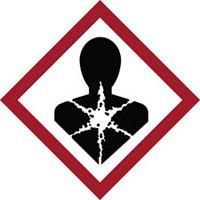



Find all of your laboratory and workplace safety supplies at Safety Emporium!
 Freezing Point |
 Glossary Index |
 Fume Hood |
| MSDS Topics |
Free Sites | FAQ's | Regulations | Glossary | Software | Suppliers |
| Books | Forum | Poll | Fun stuff | Quiz | Store | |
| Understand your MSDS with the MS-Demystifier | Search ALL our MSDS info | |||||

Get your GHS-compliant labels and signs from Safety Emporium.
A fume or fumes refers to vapors (gases), dusts and/or smoke given off by a substance as a result of a chemical transformation such as reaction, heating, explosion or detonation.
"Fumes" generally conveys the idea that the cloud is an irritating, hazardous and/or toxic substance.
The term applies particularly to very fine solid particles as a suspension in air. This closely matches the definition of dust, the main difference being that fumes are airborne whereas dusts need not be suspended in the air.
Fumes may contain both gases (vapors) and dusts. In many cases, the vapors are toxic or corrosive. For example, titanium tetrachloride (TiCl4) reacts immediately and violently with water vapor in the air to form dense white fumes. The chemical reaction that explains this behavior is:
TiCl4 + 2 H2O  TiO2(s) + 4 HCl(g)
TiO2(s) + 4 HCl(g)
The TiO2 (titania), is a solid that forms small white particles. The HCl (hydrogen chloride) is an invisible and hygroscopic gas that immediately condenses with water vapor in the air to form suspended liquid particles. The droplets in this HCl mist are acidic aqueous, solutions of hydrochloric acid.
Inhalation of these fumes is dangerous because each component is hazardous. The hydrochloric acid droplets can cause chemical burns to the respiratory system, eyes and skin; the fine particles of titania further irritate the damaged tissues.
"Fumes" can appear in multiple places/contexts on a Safety Data Sheet. For example, they might be mentioned in Section 9 (physical and chemical properties) as a physical property, e.g. "fuming liquid" or in Section 10 (stability and reactivity) with respect to incompatibility with other materials, or possible hazardous decomposition.
Fumes generally require more careful attention than simple dusts or vapors. For example, while a dust mask might be sufficient protection from some dusts, a dust mask will do nothing to protect you from titanium tetrachloride fumes which contain corrosive HCl. Likewise, an organic vapor respirator will not protect the user from fumes containing HCl.
Therefore, always try to control or eliminate the generation of fumes in the first place. Use appropriate ventilation such as fume hoods and other engineering controls. If the fumes are not adequately controlled with these methods, always use proper personal protective equipment (PPE) such as supplied air respirators.
Finally, note that many metal fumes, such as those generated in metal refining operations, soldering, and welding are significant health hazards. A general class of occupational disease is called metal fume fever. See the links below for more info.

Welding fumes are also a respiratory hazard. Remind your employees with safety banners from Safety Emporium.
See also: dust, fume hood, mist, smoke.
Additional definitions from Google and OneLook.
Entry last updated: Wednesday, December 28, 2022. This page is copyright 2000-2025 by ILPI. Unauthorized duplication or posting on other web sites is expressly prohibited. Send suggestions, comments, and new entry desires (include the URL if applicable) to us by email.
Disclaimer: The information contained herein is believed to be true and accurate, however ILPI makes no guarantees concerning the veracity of any statement. Use of any information on this page is at the reader's own risk. ILPI strongly encourages the reader to consult the appropriate local, state and federal agencies concerning the matters discussed herein.